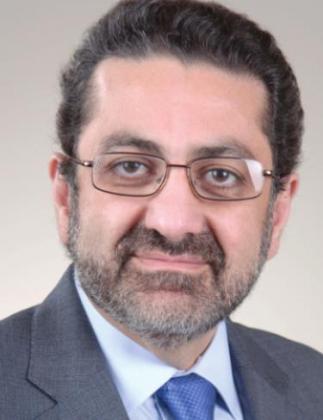ATRIAL FIBRILLATION IS THE MOST COMMON TYPE OF HEART ARRHYTHMIA, with current estimates suggesting more than 12 million Americans will have the condition by 2030.
Occurring when the heart’s upper and lower chambers don’t beat in coordination, atrial fibrillation, or AFib, can lead to heart palpitations, shortness of breath, chest pain, and fatigue. It’s also a major risk factor for stroke—about one in seven strokes are caused by AFib.
At The University of Toledo Medical Center, a dedicated team of specialists provides expert care for AFib using the latest innovations to improve patients’ quality of life and reduce their risk of stroke and heart failure. “The science of treating atrial fibrillation has become very advanced,” said Dr. Samer Khouri, head of cardiology at The University of Toledo Medical Center. “Each of our patients has an individualized treatment plan. Every person’s needs and complaints are different. Our approach for every patient is based on their specific needs.”
AFib was once treated primarily with simple blood thinners, such as warfarin, that required close monitoring, but a number of new, more easily managed medications and cutting-edge, non-invasive procedures have recently become available.
While medication alone is enough for some patients, others may require additional interventions, such as catheter ablation. In this minimally invasive procedure, a cardiologist threads a catheter into the heart where hot or cold temperatures are used to remove tissue that’s producing the erratic signals. “The goal, ultimately, is to prevent the palpitations and shortness of breath and keep the heart in sinus rhythm,” Khouri said. “This has had tremendous success in the last few years, and it showed that it improved the quality of life and even prolonged life.”
UTMC also offers a minimally invasive procedure called CryoMAZE, in which a surgeon makes a small incision in the right side of the chest and inserts a specialized probe that uses extreme cold to create a barrier of scar tissue on the outside of the heart, which prevents stray electrical signals from causing the heart to beat irregularly.
Another option for treating AFib is implantation of the Watchman device, which is inserted in the left atrial appendage via a minimally invasive procedure, closing off that part of the heart. “The Watchman device will decrease the risk of stroke by closing that appendage in the heart,” Khouri said. “Patients like it because they have no surgery and because they would be off blood thinners.”
While blood thinners are effective at reducing the risk of stroke, one of the major drawbacks is that they significantly increase the risk of dangerous bleeding following a fall or other injury. “A brain bleed can be fatal, and in those patients with a heightened risk of fall, the risk of anticoagulation medication can be higher than the benefit of a reduced risk of stroke,” Khouri said. “In the right patient, procedures like CryoMAZE or the Watchman implant can be hugely beneficial.”
Khouri said the key to any treatment for AFib is managing symptoms, improving quality of life, and reducing the risk of stroke. “Our goal is to empower our patients, make them aware of their options, and give them advice about what is the best thing for them,” he said.
To learn more about UTMC’s treatment options for AFib, call 419- 383-2342.
Tyrel Linkhorn is a communications specialist at The University of Toledo.


